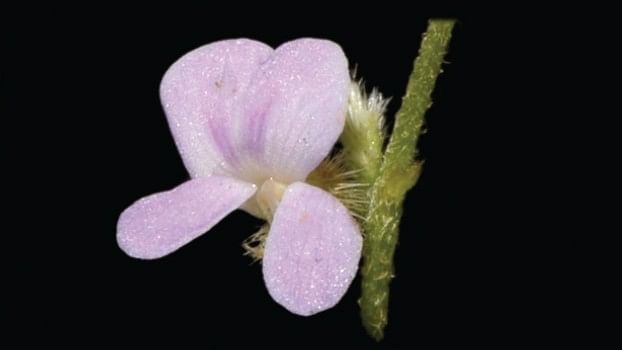
Teramnus kameswararoi, endemic to Hesaraghatta.
Credit: Special Arrangement
Bengaluru: Researchers from the Gandhi Krishi Vigyan Kendra (GKVK) have discovered a flowering legume plant endemic to Hesaraghatta, highlighting the critical need to save the grassland which is being threatened by rapid urbanisation.
In their paper published in Nelumbo, a journal of Botanical Survey of India (BSI), researchers M Sanjappa, A N Sringeswara from GKVK and N Dhatchanamoorthy from Foundation for Revitalisation of Local Health Traditions said the plant, named Teramnus kameswararoi, is confined to a small area with limited number of sub populations.
“It is considered endemic to Bengaluru Urban district and is threatened by fast urbanisation as the collection localities fall within residential and infrastructure areas,” the paper said.
The plant belonging to Teramnus (legume) family has been named Teramnus kameswararoi, in honour of C Kameswara Rao, former chairman of Botany Department, Bangalore University. Unlike eight other species of Teramnus, the kameswararoi is distinguishable as it branches from the base, rises above the ground without twining and climbing.
Sanjapa, who retired as the director of the Botanical Survey of India and currently Indian National Science Academy senior scientist at GKVK, said the day they went to verify the plant was dramatic in itself.
“The place where the plant was identified was a residential site. We saw that the land was cleared and the plant was removed. We managed to locate it and document it in three places in Hesaraghatta village. However, rapid urbanisation is a concern because there may be other species that are yet to be identified,” he said.
Sringeswara told DH that the legume plants provide a key service to nature and environment.
“The roots of legume plants are principal hosts of Rhizobium bacteria which convert atmospheric nitrogen into nitrates and enrich the soil. This will in turn benefit all other plants. The Hesaraghatta area, especially the grassland, is rich in biodiversity. We have studied the plant for one year to assess its properties. More research in the area is needed to document other possible endemic species,” he said.
Researchers Mahesh Bhat, Seshadri K S and Ramki Sreenivasan, who documented the flora and fauna of Hesaraghatta in their recommendation to declare the area a conservation reserve, had recommended key strategies for protecting its biodiversity.
They counted 39 native plant species, 10 mammals, five reptiles, 133 birds, one amphibian, three spiders and 14 species of butterflies.
The State Board of Wildlife had taken up the proposal to declare 5,010 acres of the grassland as a conservation reserve but it was put aside due to political interference. Following a direction by the high court, the Board is scheduled to take up the matter again.
Sources in the forest department said the matter was to be taken up during the meeting in August but was deferred due to the paucity of time.